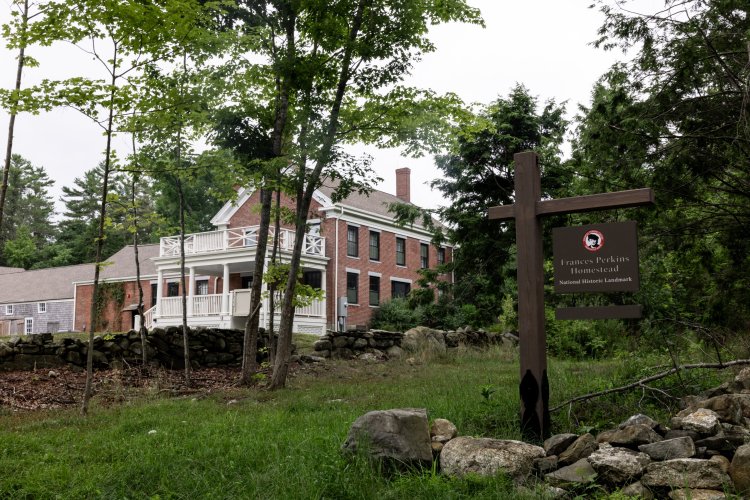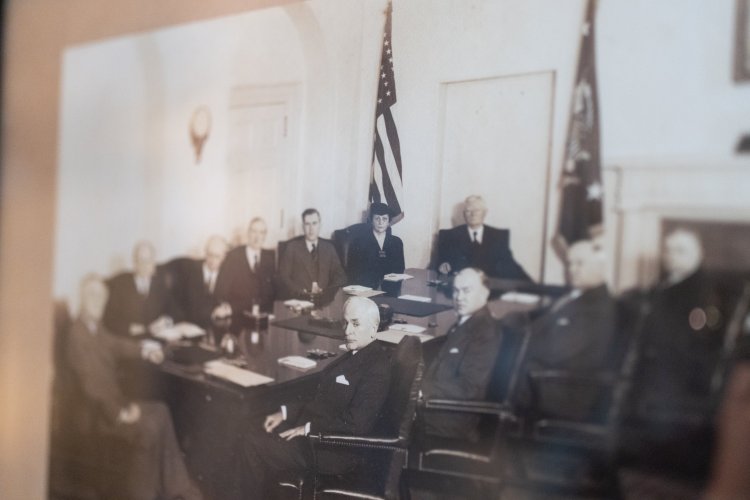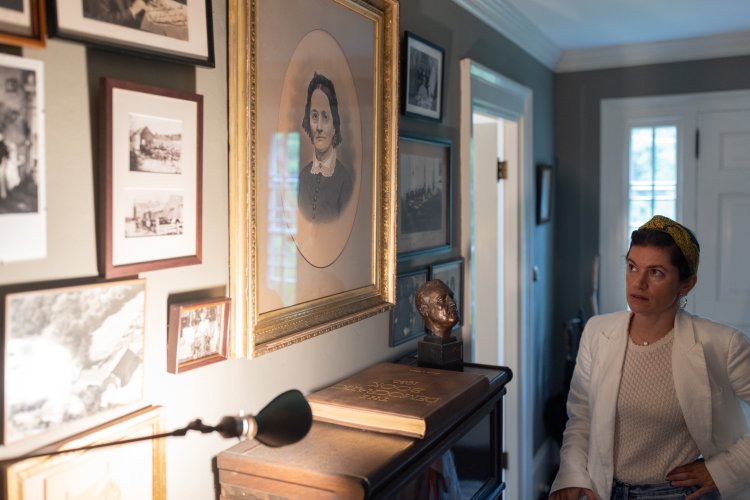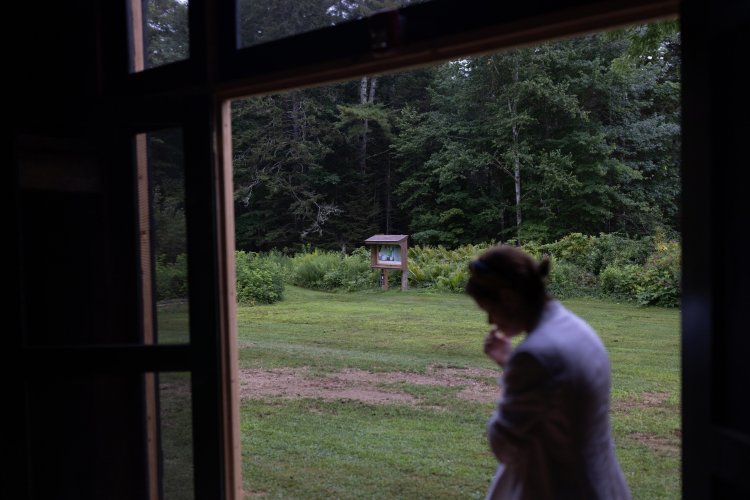Maine
Maine home of Frances Perkins, first female Cabinet member, seeks national monument designation


The Frances Perkins Homestead as seen from River Road in Newcastle. Brianna Soukup/Staff Photographer
The Newcastle home of Frances Perkins – a chief architect of Social Security and other programs that helped transform the country during the Great Depression – soon could become Maine’s second national monument.
The nonprofit Frances Perkins Center is asking President Biden to declare Perkins’ longtime family home on River Road in Newcastle a national monument, to be run by the National Park Service. It would become Maine’s second national monument, along with Katahdin Woods and Waters, which received the designation in 2016.
Officials from the Frances Perkins Center planned to announce the request Thursday during a Zoom news conference, which was scheduled to include U.S. Rep. Chellie Pingree, Maine Commissioner of Labor Laura Fortman and several others.
Perkins was the first woman to serve in a U.S. president’s Cabinet, as secretary of labor under Franklin D. Roosevelt from 1933 to 1945, and is recognized as the driving force behind such transformational New Deal measures as Social Security, the 40-hour work week, child labor laws and the minimum wage.


A photo at the Frances Perkins Center shows Perkins, in front of the flag, during a meeting of Franklin D. Roosevelt’s Cabinet in 1937. Brianna Soukup/Staff Photographer
Supporters and people who have worked on the creation of other national monuments say the Perkins site has a good chance of being approved by Biden because he issued an executive order in March directing the U.S. Department of the Interior to identify potential National Park Service sites that would honor women.
Officials at the National Parks Conservation Association, which works with the National Park Service on creating sites, is not aware of any other proposals for new National Park Service locations that would honor women besides this one, said Kristen Brengel, the association’s senior vice president of government affairs.
“There are a couple reasons why this has a really great shot at becoming a national monument, and one is that the president said he’s looking to designate more sites to honor women’s history,” Brengel said from her office in Washington, D.C. “Another is the enthusiasm from the congressional delegation in Maine and the public support there. When you look at (Perkins’) accomplishments, it puts her right up there among people who have had a huge impact on American history and people’s lives today.”
Of the 430 sites run by the National Park Service, about a dozen are dedicated to women’s history or a particular woman, Brengel said. Those include sites dedicated to abolitionist Harriet Tubman, American Red Cross founder Clara Barton, former first lady and activist Eleanor Roosevelt, pioneering Black educator and women’s rights leader Mary McLeod Bethune, and Maggie Walker, who was born to enslaved parents and became the first woman to own a bank in the United States.
Others are dedicated to more than one woman or movements in women’s history, including Rosie the Riveter, the symbol of women taking over manufacturing jobs to bolster the war effort during World War II.
Brengel said there’s no typical timetable for how long a national monument request might take to get approved. But because Biden’s executive order established his desire to have more sites dedicated to women and his term will end in January, the approval could be “sooner rather than later,” Brengel said.
Though Perkins shied away from publicity and let FDR make the grand public announcements of new programs, historians and researchers in recent years have written about her crucial importance to so many measures aimed at making working people’s lives better.
“If you had a weekend, you can thank Frances Perkins. If you or anyone you ever loved has collected Social Security benefits, you can thank her. If you’re a child who got to go to school instead of to work in a factory, you can thank her,” said Stephanie Dray, a writer who researched Perkins extensively for her historical fiction novel “Becoming Madam Secretary,” which came out in March. “She’s just everywhere around us.”
A NATIONAL HISTORIC LANDMARK
The Frances Perkins Homestead in Newcastle was designated a National Historic Landmark in 2014 and has been run by the nonprofit Frances Perkins Center since 2020, when the organization purchased the property. The center opened in 2009 with a small exhibition space in Damariscotta.


Giovanna Gray Lockhart, the executive director of the Frances Perkins Center, stands near a gallery wall of old family photos inside the Perkins family home in Newcastle. Brianna Soukup/Staff Photographer
An exhibition on Perkins’ life in a restored barn is open to the public, as are trails through the 57 acres of fields and forest on the property. The center hopes to open at least some of the 1837 brick farmhouse to visitors next year.
“Our mission is to inspire current and future generations to understand and uphold Perkins’ belief that government’s role is to help provide social justice and economic security for all, and that mission will be met by a national monument designation,” said Giovanna Gray Lockhart, executive director of the Frances Perkins Center. “So many people visit national parks and national monuments. They are the gold standard of learning about American history.”
Generally, a national park contains a variety of natural resources and covers a large area, while national monuments preserve one nationally significant area and are usually smaller, according to the National Park Service website. Lockhart said the Frances Perkins Center hopes to retain a portion of the homestead property as its headquarters, “so that our work continues.”


A sign marks the trailhead at the Frances Perkins Center in Newcastle. Brianna Soukup/Staff Photographer
Though her parents were from Maine, Perkins grew up largely in Worcester, Massachusetts, and her professional life kept her in New York and Washington, D.C., much of the time. But she came back often, including in the summer, to the farm and homestead in Newcastle, which had been in her family since the 1750s. The Perkins property is on River Road south of the Midcoast town of Damariscotta. She owned the house from 1927 until her death in 1965 at the age of 85 and is buried in Newcastle.
Perkins graduated from Mount Holyoke College in South Hadley, Massachusetts, in 1902 and later got a master’s degree in economics and sociology from Columbia University in New York City. She began a career as a social worker and economist in New York, working for the New York Consumers League and the Committee on Safety of the City of New York in the 1910s.
She married New York economist Paul C. Wilson in 1913 and had one child, daughter Susanna, in 1916. Wilson suffered from mental illness and was institutionalized frequently during their marriage. He died in 1952.
SECRETARY OF LABOR
Perkins worked on various labor-related boards and commissions before being appointed New York state industrial commissioner in 1929 by Roosevelt, who was then New York’s governor. She became Roosevelt’s secretary of labor when he became president.
At first, she didn’t want the job in Washington, said Derek Leebaert, who wrote about Perkins in his 2023 book “Unlikely Heroes: Franklin Roosevelt, His Four Lieutenants, and the World They Made.” She told FDR she’d accept only if he accepted her list of conditions, which included proposing and pushing through measures that would champion labor rights and women’s issues in a variety of ways, including Social Security and a minimum wage.
“She knew exactly what she wanted to accomplish and became the point person on all these things we know today, like Social Security or the 40-hour work week,” Leebaert said. “She saw an opportunity to get these things done, and she was extraordinarily successful.”


Lily Hayden-Hunt works on cataloging Frances Perkins’ books at the center in Newcastle. Hayden-Hunt is one of two interns from Mount Holyoke, Perkins’ alma mater. Brianna Soukup/Staff Photographer
Lockhart said many of Perkins’ views about work and the rights of working people were forged during the time she spent on her family’s Maine homestead – a farm that, for a time, had a brick-making operation.
“I think that helped shape her character and led her to believe that, if you’re working hard your entire life and you become unable to work, there should be some mechanism to help you,” said Lockhart.
Pingree, a Democrat representing Maine’s 1st Congressional District, is a ranking member of the House Appropriations Subcommittee that oversees the Department of the Interior, including the National Park Service.
A spokesperson for Pingree said in an email this week that the congresswoman is supporting the effort to create a national monument at Perkins’ home because “she was a trailblazer, the first female presidential cabinet member, the mother of the modern labor movement, and a pioneering advocate for social justice, economic security and labor rights. This monument would celebrate this special piece of Maine’s and the United States’ history.”
In a news release about Thursday’s announcement, more than a dozen other current and former Maine elected officials were quoted as supporting the proposal, including U.S. Sen. Angus King, Gov. Janet Mills, Maine Senate President Troy Jackson and Maine House Speaker Rachel Talbot Ross.
Coincidentally, the Roosevelt summer compound, preserved as Roosevelt Campobello International Park, is about a four-hour drive up the coast, just over the Canadian border from Lubec, and also is open to the public.

Maine
Shenna Bellows sworn in for third term as Maine Secretary of State

AUGUSTA, Maine — Secretary of State Shenna Bellows was sworn into office for her third term Wednesday. Governor Janet Mills conducted the formal swearing-in of all the constitutional officers, which includes Bellows, State Treasurer Joseph Perry, Attorney General Aaron Frey and State Auditor Matthew Dunlap. In her remarks following the swearing-in, Bellows shared a message of transparency and accessibility in continuing to serve the people of Maine. “It is incumbent upon us as elected officials to make government work for the people of Maine,” Bellows said. “We must reduce bureaucracy, improve efficiency, modernize our systems, and above all, bring people together in community to make life better for the people of Maine.”
The Department of the Secretary of State includes three bureaus: The Maine State Archives, the Bureau of Motor Vehicles and the Bureau of Corporations, Elections and Commissions.
Bellows emphasized her commitment to ensuring free, safe, and secure elections, modernizing government services, and preserving Maine’s history through the State Archives. She highlighted the importance of standing up for the rule of law and democracy, referring to the legacy of Civil War General Joshua Chamberlain and referencing the events at the U.S. Capitol on January 6, 2021. “This is our Chamberlain moment. We must stand up for the rule of law and do the right thing even when it is hard. As your Secretary of State, I pledge to always ensure that we have free, safe and secure elections and that we adhere to the Constitution and the rule of law in every aspect of everything that we do,” said Bellows. Bellows, Maine’s 50th Secretary of State, previously served two terms in the Maine Senate from 2016-2020 and was the executive director of the Holocaust and Human Rights Center of Maine before her election in 2021.
Maine
An endangered rabbit species is on the rise in parts of Maine
An endangered rabbit can be found in seven towns in Maine, two more than just six years ago, and the number of colonies has more than doubled to 46 known sites in that time, according to the state’s small mammal biologist.
The native New England cottontail rabbit, which is on the Endangered Species list, is found in southern Maine, but its non-native invasive species cousin the Eastern cottontail is rapidly gaining ground, said Cory Stearns, small mammal biologist.
The two species eat similar foods, the main difference being where they live. Easterns will live closer to people under decks or porches or other human structures and are less timid about open space. That allows them to proliferate in areas where the native species won’t because they prefer to hide in bushes and thickets.
The concern is that the Easterns will dominate, making it harder for the New Englands to rebound, Stearns said. Because of that and the state’s ongoing research and monitoring program, biologists are asking Maine residents to report any sightings of the two species of rabbits.
It’s difficult to tell them apart, but often the Eastern cottontail will have a white spot on its forehead. It also has bigger eyes that give them more side vision, he said.
It’s much easier to tell them apart from snowshoe hares in the winter. Snowshoes turn white, allowing them to hide in plain sight on the snow, while rabbits are brown year-round, Stearns said.
The New England cottontail saw its highest numbers in the 1960s when there were a lot of abandoned farms that provided thickets for hiding places. As the forest grew up and matured around those areas, the bushes and hidey-holes disappeared.
It now can be found in Cape Elizabeth, York, Wells, Scarborough, Kittery, Eliot and Kennebunk.
The low point was in 2018, when there were only 21 sites populated by the New England rabbits. The Easterns were first spotted in Maine in 2017 in Portland, Old Orchard Beach, the Berwicks and Wells.
The scientists collect rabbit feces, called pellets, for genetic testing to determine which species is inhabiting a space. They also can figure out how many individuals are in a colony.
If you want to help out by reporting a rabbit sighting, fill in this form on the Maine Department of Inland Fisheries and Wildlife website.
Maine
Maine lawmakers return to Augusta as session begins

AUGUSTA — The 132nd Legislature gathered at the State House Wednesday to open a new session and begin the long process of formally referring new bills to standing committees for hearings and work sessions.
Lawmakers are expected to meet in their respective chambers only one day a week through February, as work slowly ramps up on reviewing hundreds — if not thousands — of bills submitted by lawmakers. Most of the work in the coming weeks will happen during more frequent meetings of the individual committees.
The session is scheduled to end June 18.
The top issue facing lawmakers is state spending.
On Tuesday, the governor’s budget office warned legislative leaders and members of the Legislature’s budget-writing committee about a $118 million shortfall in MaineCare, the state’s Medicaid program, in the current budget, plus a projected deficit in the next two-year budget of $450 million.
The state’s current two-year budget is $10.5 billion, but existing spending commitments already approved by lawmakers would push that spending level to $11.67 billion if they are fully funded, according to the Department of Administrative and Financial Services.
Gov. Janet Mills is expected to present her budget in the coming days. She has said she plans to protect certain investments, including continuing to provide 55% of public education funding, free community college, MaineCare expansion and 5% revenue sharing with municipalities.

Speaker of the House Ryan Fecteau, D-Biddeford, speaks during first day of the 2025 legislative session on Wednesday. Joe Phelan/Kennebec Journal
In addition to reviewing and amending the budget, lawmakers will take up a slate of new legislation. The deadline submit bills is Friday. During the previous Legislature, lawmakers submitted nearly 2,300 bills.
Democrats remain in control of state government. In addition to the governorship, Democrats retained majorities in the House and Senate, albeit by smaller margins. Democrats have had a trifecta since 2019.
-

 Business1 week ago
Business1 week agoThese are the top 7 issues facing the struggling restaurant industry in 2025
-

 Culture1 week ago
Culture1 week agoThe 25 worst losses in college football history, including Baylor’s 2024 entry at Colorado
-

 Sports1 week ago
Sports1 week agoThe top out-of-contract players available as free transfers: Kimmich, De Bruyne, Van Dijk…
-

 Politics7 days ago
Politics7 days agoNew Orleans attacker had 'remote detonator' for explosives in French Quarter, Biden says
-

 Politics6 days ago
Politics6 days agoCarter's judicial picks reshaped the federal bench across the country
-

 Politics5 days ago
Politics5 days agoWho Are the Recipients of the Presidential Medal of Freedom?
-

 Health4 days ago
Health4 days agoOzempic ‘microdosing’ is the new weight-loss trend: Should you try it?
-

 World1 week ago
World1 week agoIvory Coast says French troops to leave country after decades

















